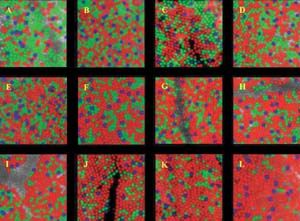

Visual Science
Study: Brain Holds Key to Color Perception
 |
| COLOR COMBO: Images of living retinas captured by a Center for Visual Science team highlight the variability in the distribution of color-sensitive cones among people who perceive colors in the same way. The red and green dots indicate the ratio between two types of cones used by the retina to process color information. Regardless of the distribution, people reported seeing the same color. (Photo: Center for Visual Science) |
First-ever images of living human retinas have yielded a surprise about how we perceive the world, according to Rochester researchers.
The findings: The number of color-sensitive cones in the human retina differs dramatically among people—by up to 40 times—yet people appear to perceive colors the same way.
The results, published in the Journal of Neuroscience, strongly suggest that the perception of color is controlled much more by our brains than by our eyes.
“We were able to precisely image and count the color-receptive cones in a living human eye for the first time, and we were astonished at the results,” says David Williams, professor of brain and cognitive sciences and director of the Center for Visual Science. “We’ve shown that color perception goes far beyond the hardware of the eye, and that leads to a lot of interesting questions about how and why we perceive color.”
Williams and his research team, led by postdoctoral student Heidi Hofer, now an assistant professor at the University of Houston, used a laser-based system developed by Williams that maps out the topography of the inner eye in exquisite detail. The technology, known as adaptive optics, was originally used by astronomers in telescopes to compensate for the blurring of starlight caused by the atmosphere.
The technique allowed researchers to shine light directly into the eye to see what wavelengths each cone reflects and absorbs, and thus to which color each is responsive.
In addition, the technique allows scientists to image more than a thousand cones at once, giving an unprecedented look at the composition and distribution of color cones in the eyes of living humans with varied retinal structure.
Williams’s team is looking to identify the genetic basis for the large variation between retinas. Early tests on the original volunteers showed no simple connection among certain genes and the number and diversity of color cones, but Williams plans to continue searching for a possible genetic combination.
